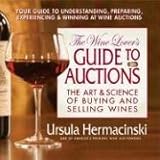Mar 25 2009
The Wine Lover’s Guide to Auctions: The Art & Science of Buying And Selling Wines
 The popularity of wine has skyrocketed in recent years. While millions of people around the world have come to appreciate both its elegance and its taste, a growing number of collectors also recognize wine as a sound investment. For these individuals, as well as for top chefs, restaurateurs, and wine enthusiasts, the wine auction has become an important place to find truly superior wines--and often at great prices! Those who are unfamiliar with these exciting events, however, may find them somewhat intimidating. Now, in The Wine Lover's Guide to Auctions, internationally renowned wine auctioneer Ursula Hermacinski removes the mystery of wine auctions by providing a clear explanation of how they work. Even the wine-auction novice can become a successful player.
The popularity of wine has skyrocketed in recent years. While millions of people around the world have come to appreciate both its elegance and its taste, a growing number of collectors also recognize wine as a sound investment. For these individuals, as well as for top chefs, restaurateurs, and wine enthusiasts, the wine auction has become an important place to find truly superior wines--and often at great prices! Those who are unfamiliar with these exciting events, however, may find them somewhat intimidating. Now, in The Wine Lover's Guide to Auctions, internationally renowned wine auctioneer Ursula Hermacinski removes the mystery of wine auctions by providing a clear explanation of how they work. Even the wine-auction novice can become a successful player.
The guide begins by exploring the fascinating history of wine auctions. It then provides information on wine basics and details the mechanics of the auction process--for buyers and sellers. You will meet all the players involved in these events and discover a number of insider secrets that will enable you to save time and money. Rounding out this book are helpful hints on starting--or expanding--your wine collection, choosing the best auction house for your needs, and organizing your own wine tasting.
Whether you plan to participate as a buyer or seller, The Wine Lover's Guide to Auctions will help you get the most out of your auction experience. Enjoy!
Customer Review: Sold!
Ursula Hermacinski has been a wine auctioneer at Christies and elsewhere for over 20 years. Her well organized book is a clear exposition of the auction process.
Part One is a summary of the history and details of auctions and a short lesson in wine basics. Part Two is a superb tutorial in reading wine catalogs; she describes the bidding process, whether you attend in person, by telephone, or increasingly on the Internet. Part Three helps you decide which auction house to use to sell wine, and details many of the pitfalls: bad wines, shipping damage, handling charges, and more. Part Four is the weakest section, a sort of hodgepodge dealing with charity auctions and learning about wine: travel to wine regions and taste lots of wine is the essence of her advice.
The book is crisply written and is a useful source of trade secrets on how to try to buy wines inexpensively. It is well to remember that Ursula Hermacinski, though, is an auctioneer and has a self interest in encouraging buyers and sellers. One reviewer found her "so motivating one can hardly wait to zip off to the next auction and wave that bidding paddle with confidence."
Go slow say I. One of my best auction hints if you are looking for a bargain is to never open the bidding. If the lot is unsold, you may be able to buy the lot by negotiation after the sale.
I've given this book only four stars for two reasons: first, except for general interest, it is applicable to only a tiny group of wine consumers. Second, the wine auction business is fast moving, driven by a number of factors including shipping laws in the United States, the growth of Internet auctions and uncertainty about the legal ramifications, and a serious problem with counterfeit wines.
If Ursula Hermacinski would enhance this book, say with an author's blog on Amazon, so she could keep her readers up to date, the book would be worth five stars for the clarity of her writing.
Customer Review: Publishers Weekly
The Wine Lover's Guide to Auctions: The Art & Science of Buying and Selling Wines
Ursula Hermacinski. Square One, $17.95 paper (256p) ISBN 978-0-757-00275-5
A foreword by wine guru Michael Broadbent intimates that this book is a serious authority on its subject-and it is. Hermacinski, who's been a wine auctioneer for more than 20 years (most of them at Christie's), presents a guide to the wine auction experience that even the most studied oenophile can learn from. The first 48 pages include an entertaining history of wine, auctions and, of course, wine auctions. There's also a solid overview of wine basics, covering grape varieties, regions, bottle shapes and sizes, storage, serving, glasses and food pairing, because understanding wine fundamentals, the author explains, is "an integral key to your success at wine auctions." Though the topic is narrow, anyone with a strong interest in wine might find it worth exploring, because auctions allow buyers to "acquire wines that are not available elsewhere because they are very old or very rare." This book takes readers through auctions' pros and cons, terminology a nd process. Hermacinski wraps up with information on wine collections and furthering one's wine education. Throughout are tidbits of wine-related trivia and an engaging, unpretentious writing style that makes the potentially intimidating world of wine auctions accessible. (July)
Comments Off